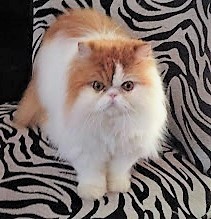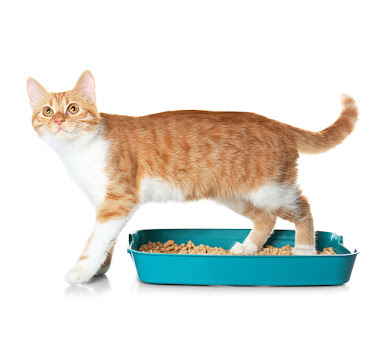Traditional veterinary treatment for feline rodent ulcers is the use of steroids and antibiotics which can provide short-term relief. Using these medications long-term can have side effects and reduced efficacy. The good news though is that holistic treatments can be used (diet changes and supplements) to help control symptoms, minimize flare-ups and change your cat's quality of life for the long term!
Feline Rodent Ulcers (also known has eosinophilic granuloma, feline eosinophilic granuloma, feline rodent ulcer, indolent ulcer, and eosinophilic granuloma ulcer of cats) is a non-contagious condition, unique to cats, where oral mucosal lesions develop. They can occur at any age but appear more often in female cats. In other words, open sores (similar to cold sores) appear, most often, on the upper lip of cats. Your veterinarian will typically diagnose rodent ulcers by the appearance and location of the ulcer (in questionable cases, a biopsy or needle aspirate cytology can be done to rule out malignant transformation). You might first notice a yellow or pink shiny spot, which deepens into a lesion. The sores can be very painful and hinder your cat's ability to eat. Their mouth might emit an unpleasant odor and over time, can become disfigured. Your cat may also show a behavioral change (aggression or withdrawal).
The conventional veterinary treatment for indolent ulcers almost always involves the use of steroids to calm the inflammation and antibiotics to clear up any secondary bacterial infection. While this may provide short-term relief, these medications can weaken your cat's immune system and cause side effects. Genetics, allergies, and autoimmune disease are common reasons why cats may develop this condition and have it long-term. Thus the goal is to introduce holistic veterinary treatments to help support your cat's immune system and minimize the frequency of flare-ups.
When your cat has an autoimmune condition such as feline rodent ulcers, your kitty's immune system is so overloaded that the cat's body forms antibodies to its own tissues and attacks itself. The onset of the attacks is associated with triggers such as food allergies, exposure to chemicals, vaccines and stress. Autoimmune conditions cannot be cured but they can be controlled. Holistic veterinary treatments, in conjunction with conventional treatments, can minimize flare-ups and reduce the need for medications. Holistic treatments entail feeding your cat a hypoallergenic, anti-inflammatory diet and using supplements that modulate the immune system.
The following supplements have been helpful for cats with feline rodent ulcers, viruses and other autoimmune conditions. These supplements have been used successfully in veterinary hospitals since 2005:
Immune Harmony- this plant sterol formula is designed specifically for autoimmune diseases. It helps to modulate your cat's immune system and is very well-tolerated.
Power Probiotic - essential for all cats, especially if your cat has been on antibiotics that kill off the friendly bacteria. Power Probiotic is the best probiotic for cats as it is pure, natural and there are absolutely NO fillers! Many cats love the taste and will eat the plain powder--please click on the link to see the video. Power Probiotic promotes the growth of friendly bacteria which ensure a healthy intestinal ecosystem and enhances overall immunity.
Quent drops - this powerful anti-viral formula is used in conjunction with NOt drops. Quent and NOT are your best line of defense against viruses, infections and a weakened immune system. These homeopathic, gentle drops are easy to administer and start helping your cat right away.
NOT Drops- a best seller for fighting infections, use NOT drops in conjunction with Quent drops to give your cat immune support to overcome feline rodent ulcers. These homeopathic drops are used on alternating nights with the Quent drops
 |
| Pumpkin |
Changing your cat's diet to a hypoallergenic, anti-inflammatory diet along with using supplements to modulate the immune system can make a dramatic improvement in your cat's quality of life and comfort. Many foods such as dry kibble can not only be painful to eat but may also contain ingredients that worsen the syndrome and increase flare-ups. If you include your cat's diet and symptoms on the order form at checkout, AskAriel.com will include a diet suggestion on the packing slip that comes with the product directions.
Need help with your cat? Click Here to visit Ask Ariel
With so many options available and so much varying information online, it can be easy to get influenced into buying certain products. But how do you know if that product is the right one for you and your cat? Let's review the important factors to consider when selecting cat litter for your kitty.
Understanding Your Cat’s Preferences
First, you need to understand your cat’s preference. Every pet is unique, and what works for one kitty may not be ideal for another. Before jumping in, take some time to consider and observe your cat. Does your cat prefer clumping or non-clumping litter? Is your cat sensitive to scents? Does your cat have respiratory issues? If you can understand your cat's preferences, it will help you narrow down your options and find the purrfect match.
Factors to Consider
There are a variety of factors to consider when choosing the best cat litter. There is not only your cat’s preferences, but your environmental and lifestyle preferences as well. Some factors may be more important to you than others, so let’s take a look at common concerns.
Odor Control: This is usually one of the most important considerations for cat owners, especially those in a smaller living space. If you are interested in odor control, look for litters with activated charcoal or other odor-absorbing ingredients to keep your home smelling fresh.
Dust Levels: Dusty litters can be irritating to both cats and humans. It may be preferable to opt for a low-dust, or even dust-free, option, especially if your cat has asthma or other respiratory issues, as inhaling litter dust has been known to exacerbate these conditions.
Tracking: Some litters are more prone to tracking than others. Choose litters with larger granules or heavier formulas if you want to minimize tracking around your house.
Environmental Impact: If sustainability is important to you, consider eco-friendly options made from biodegradable or renewable materials.
Budget: Cat litter costs can vary widely, so consider your budget when making your selection.
Types of Cat Litter
Now that you have reviewed the factors and can determine which are most important to you, you can look at the different types of litter to see if they meet your needs.
Clumping vs. Non-Clumping: Clumping litter forms solid clumps when wet, making it easier to scoop and maintain cleanliness. Non-clumping litter, on the other hand, absorbs moisture but does not clump together.
Scented vs. Unscented: Scented litter can help mask odors, but some cats may find the fragrance overwhelming. Unscented options are available for more sensitive noses.
Natural and Biodegradable Options: Eco-conscious cat owners may opt for litters made from materials like wood, paper, or corn, which are renewable and biodegradable.
Cat Litter Materials
There are a variety of brands and materials that are used for cat litter, and it seems like new ones are popping up every day. Let’s take a look at some of the most commonly used types.
Clay: This litter is made from clay materials and is probably the kind of litter someone pictures in their head when they think of a litter box. As the most commonly used type of litter, there are a lot of varieties when it comes to clumping, scent, and granule size. Clay litter is generally dusty and has smaller granules, so it may track outside the litter box. This litter should not be flushed.
Crystal: This litter is made from absorbent silica gel crystals that are usually formed as small, translucent beads. Crystal litter is considered low-maintenance as it lasts longer than clay litter and doesn’t need to be changed as frequently. This litter is dust-free, but some cats may be sensitive to the texture and it does not clump as well as other litters.
Paper: This option, made from recycled paper, is biodegradable and eco-friendly. It has good absorbency and is often low in dust, but needs to be changed more frequently and does not have much odor control.
Pine Pellets: This is an affordable litter option made from compressed pine wood pellets. It has natural odor control properties and a pine scent. Pine litter is biodegradable and can be composted after use. Some cats may not like the texture of pellets.
Walnut Shells, Coconut Husk, Corn, Wheat: These litters are generally biodegradable and environmentally friendly. They clump well and offer effective odor control, with minimal to no dust.
Making Your Decision
After considering all of these factors, it's time to make your decision. You can start by choosing a few options that meet your criteria and try them out. Remember to observe your cat's reaction and adjust as needed. With a little trial and error, you'll find the perfect cat litter that keeps both you and your beloved kitty happy!
Choosing the right cat litter is essential for maintaining a clean and odor-free litter box and keeping your cat comfortable and happy. As cat’s spend a lot of time in the litter box, you want to be conscientious of what you decide to expose them to.
Published: 4/5/2024
Author: Victoria Staton
Digital Content And Social Media Manager
A: So sorry to hear that Ginger is scratching and itching. This can be a big problem, especially during the springtime when there is a lot of pollen. For immediate relief, it is important that you do bring Ginger back to your veterinarian as you don't want her to have her infections get worse. You want to be sure that Ginger doesn't have any dog skin infections like yeast or a bacterial hot spot which can spread quickly.
Diet For Dogs With Allergies (show photo of raw diet with fish)
Every dog's needs are different and if your dog has to be on a special diet such as a low fat diet or one for another health condition like kidney disease, check with your veterinarian to make diet adjustments.
Benefits of Rabbit
- A lean all-white meat protein that offers great nutrition.
- Higher in protein than chicken, turkey, beef, duck and lamb and contains essential amino acids that help build lean muscles and boost immune system.
- Low in saturated fats, but contains healthy fats which help provide a shiny coat and healthy joints
- Contains Vitamin B12 which supports a healthy nervous system.
- Lower in fat than most other meat protein sources (such as beef and pork) and usually highly digestible
- Good source of B vitamins, zinc, phosphorous and iron.
- Can be used in homemade low-fat diets as it is more available in grocery stores.


.jpg)






